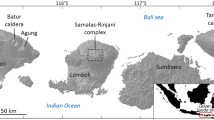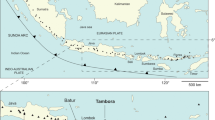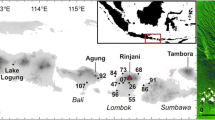Abstract
In the “great” January 1835 eruption of Cosigüina volcano, Nicaragua, andesitic magma and lithic material were erupted over a period of at least three days. Proximal facies consist of clastogenic lava, scoria-fall, and lithic ash-fall produced by phreatomagmatic to vulcanian or plinian activity, together with surge deposits and lithic block-falls. Pyroclastic flow deposits covered some flanks of the volcano and entered the sea in the Gulf of Fonseca. Little record exists of the distal ash-fall, thus the total bulk volume erupted can only be roughly constrained to 2.9–5.6 km3. Furthermore, the amount of juvenile material is thought to be small. A recent study of volatiles in 1835 scoria suggests sulfur release from the magma was negligible. This reappraisal indicates that the Cosigüina eruption probably had little global climatic impact. Despite its violent nature, the magnitude of the eruption was modest. The eruption occurred too late to initiate the Northern Hemisphere cooling trend form 1828–1836. Dry fogs and other atmospheric optical phenomena usually observed after eruptions that contribute significantly to the stratospheric aerosol burden were not recorded after 1835.
Similar content being viewed by others
References
Allard P (1983) Facing hazards from the reawakening of dormant explosive volcanoes: the examples of Mt St Helens, El Chichon, and Galunggung in 1980–1982. In: H Tazieff, JC Sabroux (eds) Forecasting volcanic events. Elsevier, Amsterdam, pp 560–584
Angell JK, Korshover J (1985) Surface temperature changes following the six major volcanic episodes between 1780 and 1980. J Clim Appl Meteorol 24:937
Barrow J (1835) Account of the Volcanic Island lately thrown up between Sicily and Pantelleria. J Roy Geog Soc 1:258–262
Briffa KR, Jones PD, Schweingruber FH (1988) Summer temperature patterns over Europe: A reconstruction from 1750 AD based on maximum latewood density indices of conifers. Quat Res 30:36–52
Caldcleugh A (1836) Some account of the volcanic eruption of Coseguina in the Bay of Fonseca, commonly called the Bay of Conchagua, on the western coast of Central America. Phil Trans R Soc Lond 1:27–30
Carey SN, Sparks RSJ (1986) Quantitative models of the fallout and deposition of tephra from volcanic eruption columns. Bull Volcanol 48:109–125
Catchpole AJW, Faurer M-A (1983) Summer sea ice severity in Hudson Strait, 1751–1870. Clim Change 5:115–139
Dollfus A, de Mont-Serrat E (1868) Voyage geologique dans les republiques de Guatemala et de Salvador. Imprimerie Impériale, Paris, pp 330–340
Feigenson MD, Carr MJ (1985) Determination of major, trace and rare earth elements in rocks using DCP-AES. Chem Geol 51:19–27
Filion L, Payette S, Gauthier L, Boutin Y (1986) Light rings in subarctic conifers as a dendrochronological tool. Quat Res 26:272–279
Galindo J (1835) On the eruption of the volcano of Cosigüina, in Nicaragua, 17th January, 1835. J R Geog Soc 1:387–392
Galindo J (1836) Eruptions of the volcano of the Cosigüina, in Nicaragua. New Philos J, Edinburgh 14:165–169
Hammer CU (1984) Traces of Icelandic eruptions in the Greenland ice sheet. Jökull 34:51–65
Kondo J (1988) Volcanic eruptions, cool summers, and famine in the northeastern part of Japan. J Climate 1:775–788
La Marche VC, Hirschboeck KK (1984) Frost rings in trees as records of major volcanic eruptions. Nature 307:121–126
Lamb HH (1970) Volcanic dust in the atmosphere; with a chronology and assessment of its meteorological significance. Phil Trans R Soc Lond 266:425–553
Legrand M, Delmas RJ (1987) A 220-year continuous record of volcanic H2SO4 in the Antarctic ice sheet. Nature 327:671–676
Mass C, Schneider SH (1977) Statistical evidence on the influence of sunspots and volcanic dust on long-term temperature records. J Atmos Sci 34:1995–2008
Palais JM, Sigurdsson H (1989) Petrologic evidence of volatile emissions from major historic and prehistoric volcanic eruptions. Am Geophy Union Monograph (in press)
Pyle DM (1989a) The thickness, volume and grainsize of tephra fall deposits. Bull Volcanol 51:1–15
Pyle DM (1989b) New estimates for the volume of the Minoan eruption. Thera and the Aegean world III. Third International Congress Santorini, Greece (in press)
Reclus E (1891) Nouvelle Géographie Universelle. Paris, 17:488–489
Roulin (1837) Cendres d'un volcan de l'Amérique Centrale. C R Acad Sci Paris 5:801–802
Sapper K (1913) Die mittelamerikanischen Vulkane. Petermanns Mitt. (Gotha), Ergänzungsheft 178
Scrope GP (1872) Volcanoes. Longmans, Green, Reader, and Dyer, London pp 170
Self S, Rampino MR (1988) The relationship between volcanic eruptions and climate change: still a conundrum? Eos Trans Am Geophys Union 69:74–75
Self S, Rampino MR, Barbera JJ (1981) The possible effects of large 19th and 20th century volcanic eruptions on zonal and hemispheric surface temperatures. J Volcanol Geotherm Res 11:41–60
Simkin T, Siebert L, McClelland L, Bridge D, Newhall C, Latter JH (1981) Volcanoes of the world. Smithsonian Inst Washington, pp 232
Taylor BL, Gal-Chen T, Schneider SH (1980) Volcanic eruptions and long-term temperature records: an empirical search for cause and effect. Quart J Roy Meterol Soc 196:175–199
Thompson LG, Mosley-Thompson E (1981) Temporal variability of microparticle properties in polar ice sheets. J Volcanol Geotherm Res 11:11–27
Walker GPL, Self S, Wilson L (1984) Tarawera 1886, New Zealand- a basaltic plinian fissure eruption. J Volcanol Geotherm Res 21:61–78
Williams H (1952) The great eruption of Cosigüina, Nicaragua. Univ Calif Publ Geol Sci 29:21–46
Author information
Authors and Affiliations
Rights and permissions
About this article
Cite this article
Self, S., Rampino, M.R. & Carr, M.J. A reappraisal of the 1835 eruption of Cosigüina and its atmospheric impact. Bull Volcanol 52, 57–65 (1989). https://doi.org/10.1007/BF00641387
Received:
Accepted:
Issue Date:
DOI: https://doi.org/10.1007/BF00641387




